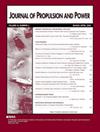空腔火焰保持固体燃料冲压发动机燃料颗粒的回归与火焰结构
IF 2.4
4区 工程技术
Q2 ENGINEERING, AEROSPACE
引用次数: 0
摘要
将空腔式火焰稳定器引入固体燃料冲压发动机燃料颗粒中,表明在以前不利的几何形状下,燃料负载增加,持续燃烧。为了维持燃烧,燃料的体积负荷提高了26%。给出了空腔燃料颗粒的回归模式,并表明实施空腔火焰稳定器的效果是改变最大回归的位置和重新附着点。空腔火焰稳定器的添加似乎对燃烧效率没有显著影响。然而,值得注意的是,由于增加的质量添加和与较高回归率相关的较高当量比,较长的空腔使腔室压力增加到高于中心穿孔燃料颗粒所观察到的压力。采用四阶不连续伽辽金有限元求解器,采用新的小火焰和进度变量公式进行了大涡模拟计算。预测结果与实验结果一致,并指出作为主要火焰稳定器机构的较长空腔的传热增加。较大的热反馈由更强的再循环区域的形成所支持,这导致由于局部和全局不稳定性之间的转变而增加的相干波动。本文章由计算机程序翻译,如有差异,请以英文原文为准。
Regression and Flame Structure in Cavity Flameholding Solid-Fuel Ramjet Fuel Grains
Introducing cavity flameholders into a solid-fuel ramjet fuel grain demonstrated increased fuel loading with sustained combustion in previously unfavorable geometries. Volumetric fuel loading improvements of up to 26% were demonstrated to sustain combustion. Regression patterns of cavity fuel grains are presented and show that the effect of implementing a cavity flameholder is to change the location of maximum regression and the reattachment point. The addition of a cavity flameholder does not appear to have a significant effect on combustion efficiency. However, it is noteworthy that longer cavities increased the chamber pressure above what was observed for a center-perforated fuel grains as a result of the increased mass addition and higher equivalence ratio associated with the higher regression rate. Large-eddy simulation computations were performed using a fourth-order discontinuous Galerkin finite element solver with a novel flamelet and progress variable formulation. The predictions agree well with the experiments and point to the increased heat transfer for longer cavities as the main flameholder mechanism. The larger heat feedback is supported by the formation of a stronger recirculation region, which leads to increased coherent fluctuations due to the transition between local and global instabilities.
求助全文
通过发布文献求助,成功后即可免费获取论文全文。
去求助
来源期刊

Journal of Propulsion and Power
工程技术-工程:宇航
CiteScore
4.20
自引率
21.10%
发文量
97
审稿时长
6.5 months
期刊介绍:
This Journal is devoted to the advancement of the science and technology of aerospace propulsion and power through the dissemination of original archival papers contributing to advancements in airbreathing, electric, and advanced propulsion; solid and liquid rockets; fuels and propellants; power generation and conversion for aerospace vehicles; and the application of aerospace science and technology to terrestrial energy devices and systems. It is intended to provide readers of the Journal, with primary interests in propulsion and power, access to papers spanning the range from research through development to applications. Papers in these disciplines and the sciences of combustion, fluid mechanics, and solid mechanics as directly related to propulsion and power are solicited.
 求助内容:
求助内容: 应助结果提醒方式:
应助结果提醒方式:


